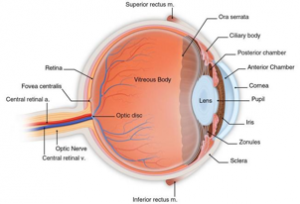Thanks to Dr. Guy for today’s Morning Report (presented on 4/9/2012)!
Central Retinal Artery Occlusion
Epidemiology:
- 55% mortality rate over 9 years
- 2% bilateral involvement
- mean age 62
Pathophysiology:
- emboli in retinal artery/ branches
- ophthalmic artery from intraorbital branch of internal carotid artery
- ischemia and edema
- irreversible cell injury occurs after 90-100 minutes
Presentation:
- acute painless vision loss
- non-progressive vision loss
- branch retinal artery occlusion:
- Amaurosis fugax- transient visual acuity loss preceding persistent loss of vision
- peripheral vision field loss
Risk factors:
- Systemic hypertension seen in 2/3 of patients
- atherosclerosis
- myopia
- DM
- CAD
- atrial fibrillation
- valvular disease ¼
- cardiac abnormalities
- ss disease
- ocd
- vasculitis
- embolism
- cholesterol, calcific, bacteria, endocarditis, coaguloopathies, antiphospholilipid syndromes
Exam:
- boxcar appearance of the blood column can be seen in both arteries and vein
- afferent pupillary defect
- cherry red spot and ground glass retina- 1 hour after development
- pale optic disk seen days to weeks after event
- emboli seen 20%
Management:
- Emergency- call ophthalmology
- Controversy exists regarding the optimal window of treatment in humans
- Conservative approach involves treatment up to 24 hours
- Directed towards lowering IOP and increasing perfusion
- Only 25% regain baseline vision
- Give O2, peripheral thrombolytics, ocular massage, aspirin, hyperbarics
- Long term risk modifications
Thanks for reading! Leave your comments below, we would love to hear from you.
The views expressed on this blog are the author's own and do not reflect the views of their employer. Please read our full disclaimer here. Any references to clinical cases refer to patients treated at a virtual hospital, Janus General Hospital.
The following two tabs change content below.


Jay Khadpe MD
Editor in Chief of "The Original Kings of County"
Assistant Professor of Emergency Medicine
Assistant Residency Director
SUNY Downstate / Kings County Hospital
Latest posts by Jay Khadpe MD (see all)
- Morning Report: 7/30/2015 - July 30, 2015
- Morning Report: 7/28/2015 - July 28, 2015
- IN THE STRETCHER INSTEAD OF BESIDE IT - July 22, 2015
- Morning Report: 7/14/2015 - July 14, 2015
- Morning Report: 7/10/2015 - July 10, 2015


Are “peripheral thrombolytics” really part of the management? It is mentioned quite matter-of-factly after “O2” and before “ocular massage”.
For me, CRAO is one of those frustrating dx that we all learn about is a true “emergency” but with no therapy that has proved to be particularly effective. I don’t think there is good evidence supporting any of the therapies suggested. There are some case series and reports about the use of lytics- both IV and intra-arterial, but no good RCT. Part of the problem, I think, is this is a rare disease so it is difficult to get the numbers to demonstrate a benefit. So, there may be some ophto people out there that may be using it, but definitely not standard of care.